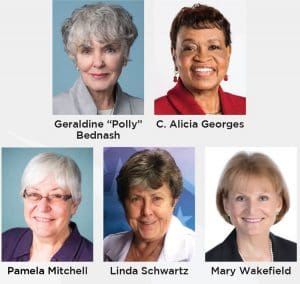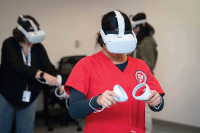The American Academy of Nursing will officially designate five exceptional leaders as Living Legends at the Academy’s Transforming Health, Driving Policy conference in Washington, DC, on October 24. As change agents and champions, these individuals have demonstrated a lifelong commitment to transforming health care. Using their nursing knowledge, they have spearheaded academic, practice, policy, and social change with extraordinary impact.


Countless lives, families, communities, and systems have improved as a direct result of the tenacity, expertise, and passion demonstrated by the following leaders honored as the 2019 Academy Living Legends.
The 2019 Living Legends are:
Geraldine “Polly” Bednash, PhD, RN, FAAN, is a powerful leader recognized nationally and internationally for her work to advance nursing education.
C. Alicia Georges, EdD, RN, FAAN, is a leader in academic nursing, health policy development, community engagement, organizational development, and healthy aging.
Pamela Mitchell, PhD, RN, FAHA, FAAN, is highly regarded for her work as a clinical nurse specialist and nurse scientist in neuroscience and critical care nursing.
Linda Schwartz, DrPh, RN, FAAN, a decorated U.S. Air Force veteran of the Vietnam War, has tirelessly dedicated her life to improving the health of veterans.
Mary Wakefield, PhD, RN, FAAN, is a renowned trailblazer and advocate whose career has produced tremendous impact on health policy through her role in several high-profile positions within the federal government.
Read more about the 2019 Living Legends.
Join the new generation of the Nurses’ Health Studies
Nurses are invited to join NHS3, the new generation of the Nurses’ Health Study. Since it was launched in the 1970s, the study’s findings have changed scientific knowledge, national and global policy, and individual lifestyles. More than 238,000 nurses and nursing students in the United States and Canada currently participate.
Participants contribute to research on nurses’ health, cancer, cardiovascular disease, reproductive issues, and other important topics by completing convenient online questionnaires. Participation takes only about 1 hour a year.
Nurses and nursing students born after January 1, 1965 and living in the United States or Canada are eligible to join NHS3.
Become part of a renowned nursing tradition that helps protect nurses’ health and the health of people everywhere. Every time you read about the study’s findings in scientific journals or the mass media, you’ll take pride in knowing that you contributed to important research.
Learn more and join at here.
New ANA position statement addresses volunteerism
Nurses often express a desire to serve others as a volunteer. ANA’s new position statement, Ethical Considerations for Local and Global Volunteerism, provides ethical guidance for nurses who participate in short- term volunteer efforts within their community and across borders. The statement, supported by the Code of Ethics for Nurses with Interpretive Statements, recognizes the social responsibility required of nurses who volunteer.




















